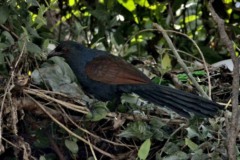The Rose-ringed Parakeet, alternatively known as the ringneck parrot in aviculture or the Kramer parrot, is a medium-sized parrot belonging to the Psittacula genus within the Psittacidae family. Its natural habitat is fragmented, spanning regions in both Africa and the Indian Subcontinent. Here is some information about the Rose-ringed Parakeet:
Rose-ringed Parakeet: Psittacula Krameri
The Rose-ringed Parakeet, scientifically known as Psittacula krameri, aka Alexandrinus krameri, is a colorful and charismatic bird species known for its vibrant plumage and distinctive ring around its neck. Notably, it has been introduced to various other parts of the world, where feral populations have established themselves, often driven by the exotic pet trade.
This parrot species stands out as one of the few that have successfully adapted to disrupted habitats, withstanding the challenges posed by urbanization and deforestation. Due to its popularity as a pet, escaped individuals have formed colonies in numerous cities globally, including regions in Northern and Western Europe.
Remarkably, these parakeets have displayed the capacity to thrive in diverse climates beyond their original range, enduring even the colder winter temperatures of Northern Europe. While the species is considered of least concern by the International Union for Conservation of Nature (IUCN), indicating a stable or increasing population, it faces challenges in certain parts of its native habitat due to its desirability as a pet and conflicts with local farmers.
Rose-ringed Parakeet / Ringneck Parrot Description
1. Size: Rose-ringed Parakeets are relatively small parrots, measuring about 40 cm (16 inches) in length, including their long tail feathers.
2. Plumage: These parakeets exhibit sexual dimorphism, meaning males and females have different plumage. In males, the plumage is striking with bright green feathers. They have a prominent rose-pink collar or ring around their neck, which is a key identifying feature. The wings display vibrant shades of blue, and the tail is long and pointed.
3. Females: Females, on the other hand, lack the rose-pink collar and generally have a more subdued appearance with green plumage and a pale, grayish head.
4. Eyes: They have small, dark eyes, and their beaks are sharp and curved for feeding.
5. Behavior: Rose-ringed Parakeets are highly social and often found in pairs or small flocks. They are agile and acrobatic flyers, capable of swift and nimble maneuvers in flight.
Habitat and Geographic Range
6. Geographic Range: Rose-ringed Parakeets are native to a vast region that includes parts of Africa and South Asia. They are found in countries like India, Sri Lanka, Pakistan, Nepal, and across Africa, from Mauritania to the Arabian Peninsula.
7. Habitat: These parakeets are adaptable and can thrive in a variety of habitats. They are commonly found in urban and suburban areas, where they have adapted to human settlements, parks, gardens, and farmlands. They also inhabit forests, woodlands, and agricultural areas.
Behavioral Adaptations to Habitat
8. Adaptability: Rose-ringed Parakeets have displayed a remarkable ability to adapt to different environments, including urban and rural landscapes. They are known for their willingness to live in proximity to humans, often making their homes in cities and towns.
9. Feeding Habits: Their diet primarily consists of fruits, vegetables, seeds, nuts, and flowers. In urban areas, they are often seen foraging for food in gardens and orchards, where they may feed on a variety of cultivated crops.
10. Nesting: These parakeets are cavity nesters, which means they seek out tree hollows or other suitable openings for nesting. In urban settings, they sometimes use buildings or even electrical utility boxes as nesting sites.
11. Social Behavior: Rose-ringed Parakeets are social birds and are frequently seen in small flocks. They communicate with each other through various vocalizations, including squawks and chirps.
12. Roosting: They often roost in communal groups, gathering in trees or other elevated perches for the night.
13. Flight: Their agile flight allows them to move swiftly and easily between feeding and roosting locations, which contributes to their adaptability in diverse habitats.
14. Breeding: Breeding pairs engage in courtship rituals, which may involve mutual preening and displaying their bright plumage. They lay eggs in their chosen nesting sites and care for their young.
Overall, the Rose-ringed Parakeet is a fascinating bird species known for its adaptability, vibrant plumage, and ability to thrive in various habitats, including urban environments. Its presence adds a splash of color and lively chatter to the areas it inhabits.








